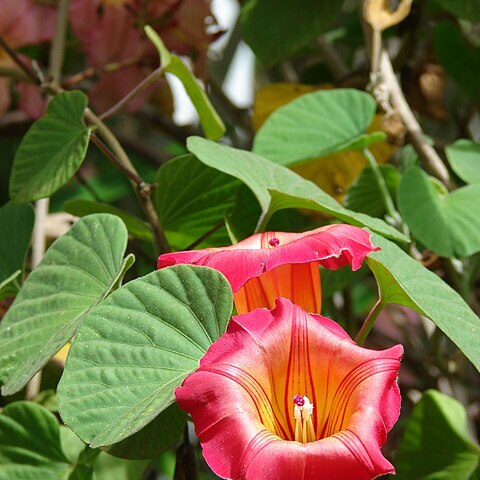Twiners woody or herbaceous. Leaves petiolate, ovate to circular, abaxially spotted with minute glands, as black dots in dried specimens, base usually cordate, margin entire. Cymes axillary, 1-to many flowered, peduncled; bracts early deciduous, small. Sepals ovate to elliptic or circular, equal or slightly unequal, much enlarged in fruit, ± leathery, abaxially glandular punctate, margin membranous, apex obtuse to emarginate. Corolla funnelform, midpetaline bands ± pilose and with minute glands. Stamens and pistil included; filaments filiform, inserted near corolla base; pollen globular, pantoporate, finely spiny. Disc ring-like. Ovary glabrous, 4-loculed; ovules 1 per locule. Style 1; stigma 2-globular. Fruit enclosed by enlarged calyx, globose; pericarp thin, eroding irregularly between septa to produce a lanternlike effect. Seeds 4 or fewer, pubescent.
Vines to about 4 m in length, perennial; stems puberulent, glabrate, the older stems with exfoliating bark. Leaves petiolate, cordate, apically acuminate, entire, glabrate above and beneath but covered with small black glandular trichomes beneath. Flowers in 1-3-flowered axillary cymes; sepals subequal, orbicular with black glandular trichomes, becoming coriaceous and clasping in fruit; corolla funnelform, red or scarlet to purplish-red, the limb usually entire; stamens included, the filaments glandular-pubescent at the base, filiform above, the anthers oblong, pollen pantoporate, spheroidal, spinulose; ovary bilocular, the style longer than stamens, the stigma capitate, biglobose. Fruits indehiscent, thin-walled, surrounded by enlarged fleshy sepals, subspheroidal; seeds 4, ovoid, grayish brown, minutely pubescent.
Woody or herbaceous twiners. Leaves mostly ovate or orbicular, cordate at the base, densely covered with minute glands beneath. Flowers in axillary, peduncled, 1–many-flowered cymes. Sepals 5, subequal, ovate to orbicular, subacute or more usually blunt, truncate or emarginate, enlarging in fruit. Corolla red or purple, large, funnel-shaped. Pollen spinulose. Ovary glabrous, 4-locular, each loculus with one ovule; style simple; stigma biglobular. Fruit globular, enclosed by calyx; pericarp thin, breaking irregularly. Seeds 4, pubescent.
Corolla large, red or purple, funnel-shaped with shallowly-lobed to subentire limb; the midpetaline areas often somewhat hairy and with minute glands like the leaves.
Sepals 5, subequal, ovate to circular, subacute or more usually blunt, truncate or emarginate enlarging in fruit, subcoriaceous, often much imbricate.
Leaves entire, ovate to circular, cordate at the base, densely covered with minute glands beneath (appearing as black dots in dried specimens).
Fruit globular, completely enclosed by the accrescent calyx; pericarp thin, breaking irregularly.
Ovary glabrous, 4-locular, each loculus with one ovule; style simple; stigma biglobular.
Flowers in axillary, peduncled, 1-many-flowered cymes; bracts small, deciduous.
Stamens inserted near the base of the corolla tube; pollen globose, spinulose.
Disk annular, entire or somewhat 5-lobed.
Herbaceous or woody twiners.
Seeds 4, pubescent.

